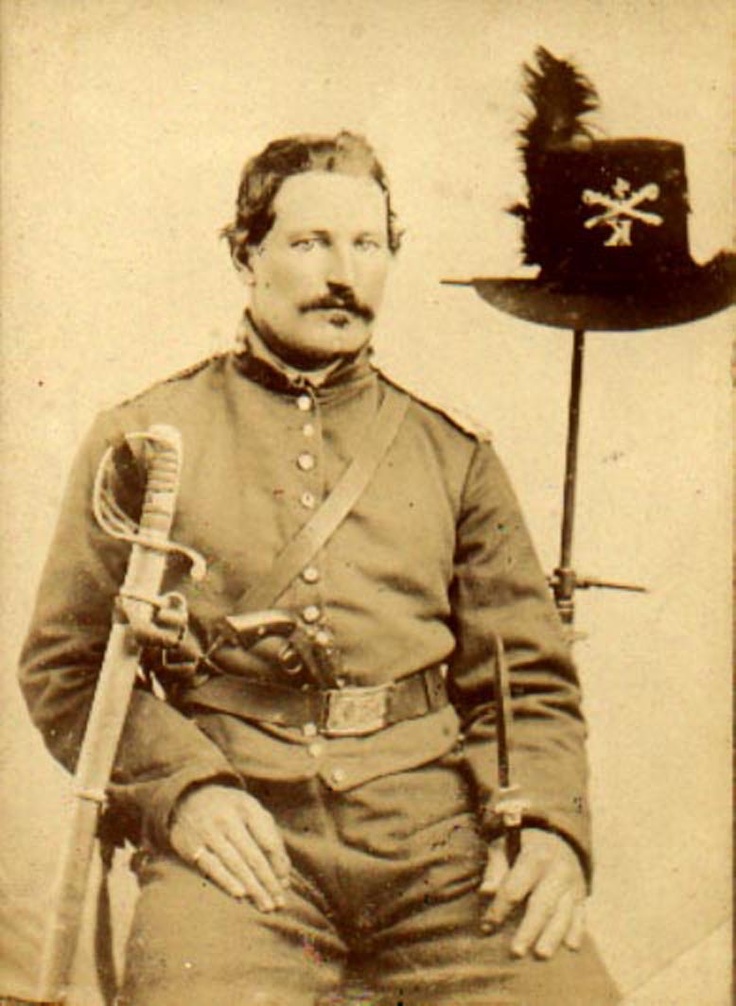
Please send all Checks and Money orders to :
Dave Taylor P.O. Box 87 Sylvania, OH 43560
419-842-1863
Click Here to E-mail Us!
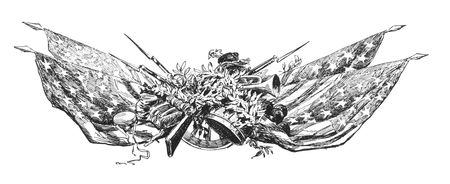
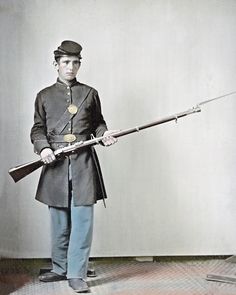
17-06-01
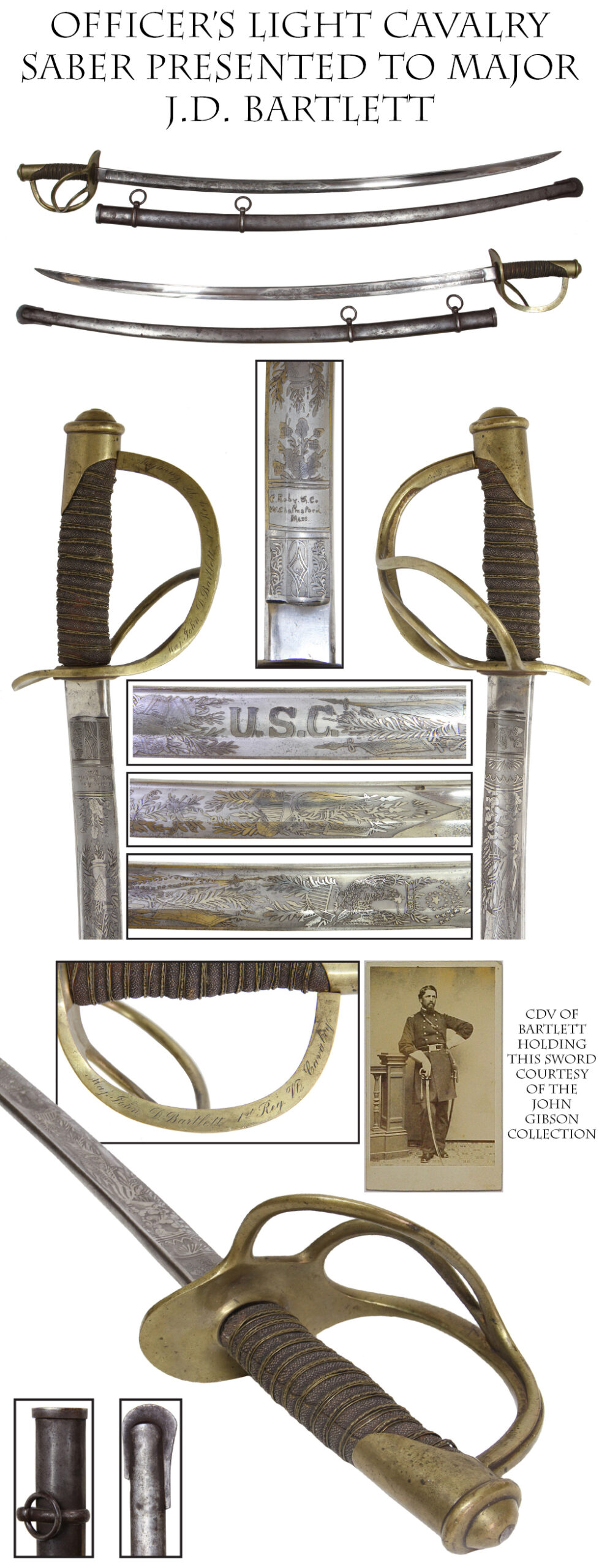
17-06-83… INSCRIBED ROBY CAVALRY OFFICERS SABER OF MAJOR JOHN D. BARTLETT, FIRST VERMONT CAVALRY… The First Vermont Cavalry was a hard-fighting unit with an interesting history. The Governor of Vermont felt he had no authority to raise a mounted regiment, so Lemuel Platt of Colchester, Vt., applied directly to the US Secretary of War and received permission to raise a regiment under US auspices. The saber’s owner, John Durrill Bartlett (1830-1907) of Montpelier acted as one of his recruiting officers, raising a company in Washington County and putting his own name down on the enrollment list on September 9, 1861. On October 7, he was elected Captain of the company, which was designated Company C, and was given a commission dated November 1, conferring the rank upon him as of October 14. Interestingly, his first lieutenant was William Wells, who gained brevet rank as both brigadier and major general in the course of the war. He must have been considered a capable officer, for he was shortly afterwards promoted to Major, as of November 8, 1861. The regiment mustered into the US service on November 19 and departed for Washington on Dec. 14, and was assigned to the cavalry of Bankss Division. Bartlett served with the regiment until early April, when he got word that his wife and child were ill and he received a leave of absence to return home. This was extended, but Bartlett tendered his resignation by telegram on April 23 and it was accepted on April 25. Bartletts sword is a very nice example of the Roby Type-1 cavalry officers saber with a plain hilt and engraved blade. The brass hilt has an untouched, mellow patina with a full sharkskin grip wrap showing just minor wear from handling. The three strands of wire binding are present as well, though some of the thin border strands are a little loose. The knuckle guard has a beautiful period, script inscription Maj. John D. Bartlett 1st Reg. Vt. Cavalry. The blade is in the bright, with very visible etching and traces here and there of the original gilt highlighting. The blade etching shows the expected mix of floral and military motifs, along with an American eagle perched on a US shield with a laurel wreath overhead as well as a circle and an arc of stars. Characteristic of the Roby etching, instead of a US there is a USC for United States Cavalry etched in the middle of the blade on one side. The scabbard, like the hilt, is plain, having standard iron mounts and rings. Roby has a well-known connection with the regiment. Thillman illustrates another 1st VT Cav. officers Roby saber and, since the outfit was recruited by the central government, the US directly purchased 410 enlisted cavalry sabers for the regiment from the firm that were regimentally marked at the ricasso, making them very scarce pre-contract sabers. Bartlett eventually moved to Massachusetts, where he died in 1907. His wife is buried beside him, but the only child I have found reference to was a son born in 1871. Further research will probably fill out the story, but it looks like his wartime visit home may have had a tragic ending. A beautiful, scarce, very early war Roby officers saber carried by an officer who helped raise and train one of the top fighting cavalry regiments in the Union Army. $2,500.00 sold
Call us @ 419-842-1863
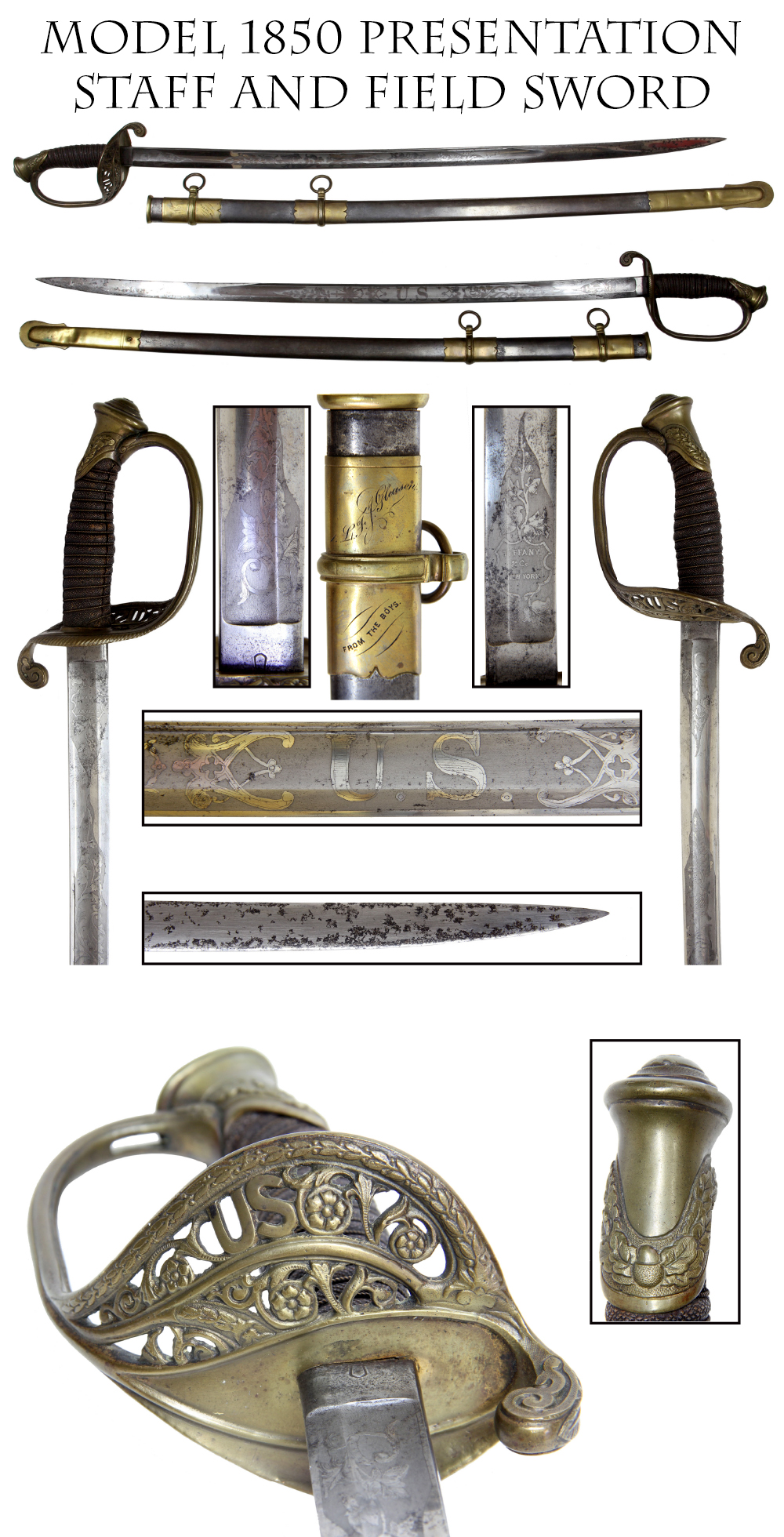
17-06-84… SIGNED TIFFANY – MODEL 1850 PRESENTATION STAFF AND FIELD SWORD TO LT. F.J. GLEASON 4th NEW YORK HEAVY ARTILLERY & 188th NEW YORK VOLUNTEER INFANTRY … Frank J. Gleason served in two New York regiments during the Civil War: the 4th New York Heavy Artillery from 1862 to 1864 and the 188th New York Infantry in 1864 and 1865. This sword was almost certainly presented to him during his service in the 4th NYHA when he rose from private to sergeant major and then to lieutenant. Lt. F. J. Gleason is beautifully inscribed in script in a scrolling line on the upper scabbard mount, and just below it in small block letters is, From the boys, indicating a long period of familiarity with the regiments enlistedmen. Gleason enrolled at Rochester, NY, at age 28 to serve three years and mustered in as a private in Co. C of the 4th NYHA on Jan. 2, 1862. He was promoted to Sergeant Major, the senior non-commissioned officer rank, on February 3, 1863. He received a commission as Second Lieutenant on January 16, 1864, giving him rank from Dec. 27, 1863, and he was mustered into Co. H on February 6, 1864, and then transferred to Co. M on April 12. He was discharged a little more than a week later, on April 21, 1864. While with the 4th he arrived in Washington in February, 1862, where the regiment manned the heavy guns in the forts surrounding the city, and also drilled as infantry. In the Spring of 1864, Grant took advantage of this reserve manpower and ordered many of the heavy artillery regiments into the field as infantry with the Army of the Potomac in late March. Gleason was lucky in the heavy fighting. Despite the heavy casualties the regiment suffered in Grants overland campaign, he came through the battles unhurt. After his discharge, he reenlisted in the army and saw action at Petersburg with the 188th NY Infantry. There, too, he was a lieutenant, and undoubtedly carried this sword in that regiment as well. He signed up in October, 1864, to serve one year and was mustered in as First Lieutenant of Co. H on Oct. 17. His commission did not come through until Feb. 4, 1865, but it gave him rank from October 12, showing that he was serving in that capacity from that date at least. Gleason was discharged from the 188th on Feb. 22, 1865. During this time the regiment served in the Fifth Corps of the Army of the Potomac at Petersburg and was engaged twice at Hatchers Run: in October and again in early February. The sword is a very handsome regulation staff and field officers sword with metal scabbard and US amid the openwork floral motifs on the guard. The sharkskin grip is complete and shows just minor abrasions from handling. The single strand of twisted wire binding is in place. The brass has an untouched, aged patina and the detail of the casting is quite good. The pommel shows a detailed chain of oak leaves and an acorn dead center along the border. The small leather pad at blade shoulder is missing, but that reveals the trapezoidal blade makers mark. The blade for the most part shows bright with just some scattered light gray spots, even with some muted frosting around some of the etched panels. There are some dark gray spots of shallow pitting on the last few inches of the blade just up from the tip, The etched motifs are a mix of floral motifs with a US midway on the blade, and it bears the Tiffany & Co. New York retailers logo etched in a shield shaped panel just above the ricasso. The scabbard is the regulation pattern with brass throat, mounts and drag. It retains most of the blue finish. There are a couple of minor dings on the drag and one on the reverse of the upper mount. All in all this is an impressive presentation sword. A superior sword for the recipient’s rank, given as a token of respect by the men who served with him…. to one of their own who had made good. And a Tiffany product as well. $2,950.00
sold
Call us @ 419-842-1863
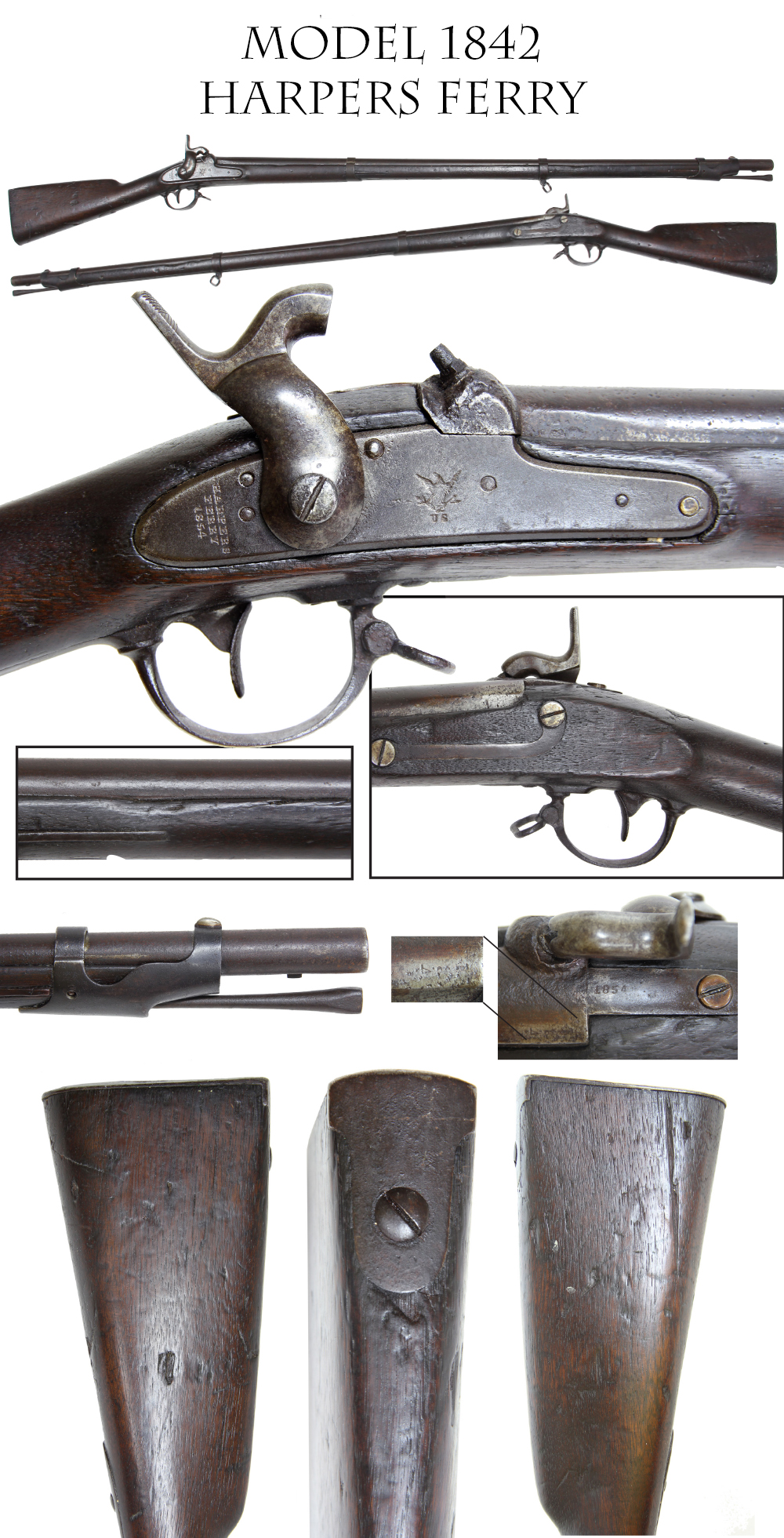
17-06-85…. MODEL 1842 HARPERS FERRY VIRGINIA MUSKET: A nice veteran musket, used but not abused. Clear lockplate stamp aft of the hammer: Harpers / Ferry / 1854 and a Harpers Ferry style eagle over a small US forward. Matching barrel date and visible, but somewhat light V/P/eaglehead barrel proofs at left breech. The corners of the wood show some slight rounding from handling, but are still well defined. There are some dings, old scratches and small divots in the buttstock, but nothing too unsightly, just enough to show its age and service. Some wear to the upper edge of the forestock at the barrel channel. The metal is a smooth plum brown mixed with some light gray here and there, with some slight firing corrosion at the bolster. Mechanics are good. Springs, swivels, etc. are in place. Rod shows some flattening to the sides at the tip, perhaps the work of a bored soldier. Bayonet lug is in place. The first of the widely issued percussion infantry longarms and the last of the .69 caliber tradition. With an 1854 date, this one is a good candidate for early service on the plains or in the hands of southern militia at the outbreak of the Civil War. An exxential US infantry longarm for the collector. $975.00
sold
Call us @ 419-842-1863
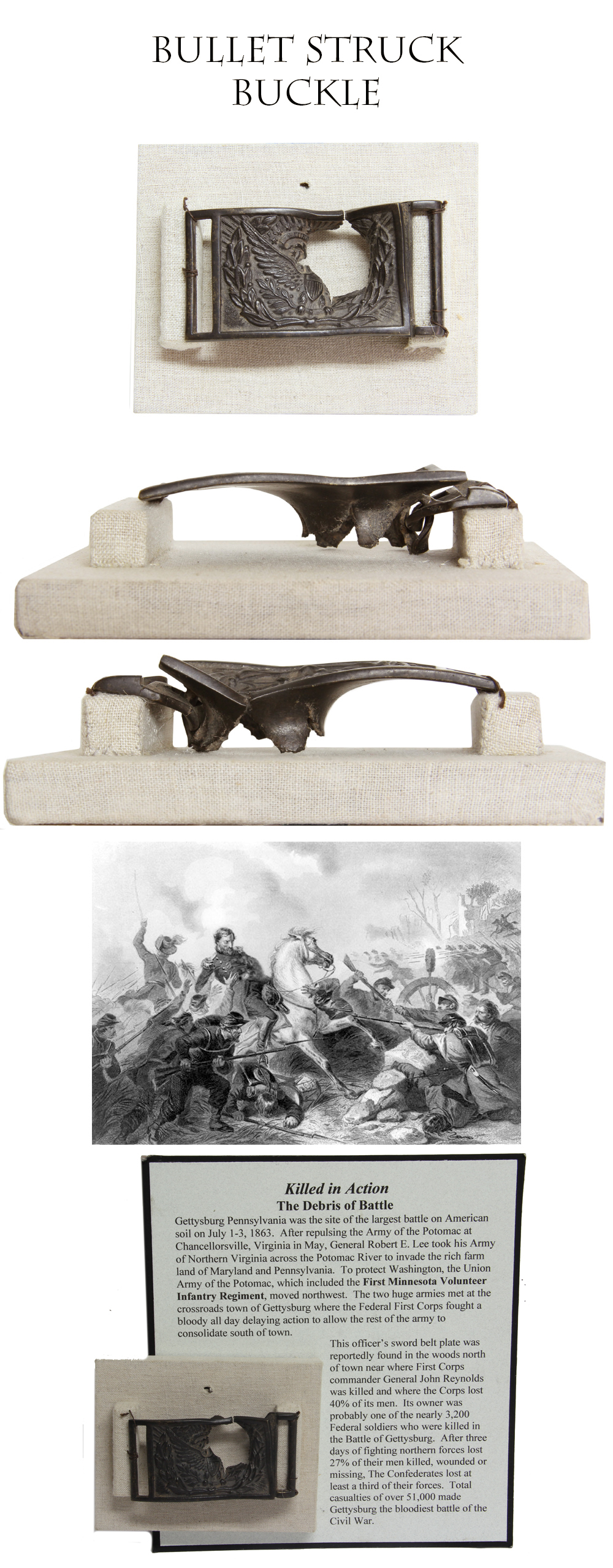
17-06-86… BULLET STRUCK OFFICER’S EAGLE BUCKLE WEARER KIA: One of the most visually exciting relics I have owned or seen. When I found it, I knew I had to have it. The sheer force of the impact is immediately evident. It is a model 1851 US officers sword belt plate caved in from the front by the impact of a bullet or grape shot. The impact splayed the edges of the hole in the plate backwards. It also resulted in the bending and locking of the narrow tongue on the plate to the separate keeper in a knot that can’t be undone. This fact is extremely important. Bullet struck plates fall into two categories… Plates struck while on the soldier’s person … or … Plates that were used as targets by bored soldiers wanting to hone their marksmanship skills. If the plate is found on a battlefield we assume it was being worn. If the plate is found in a winter camp we assume the second category. Most bullet struck plates are found near camps. The fact that this plate was attached to the keeper when struck is excellent Prima Facie evidence that the buckle was obviously clasped and in use on the belt when it was struck. It would seem impossible that the wearer could have survived being so severely gut-shot. The patina is a smooth deep greenish black. When I was a kid, the diggers referred to dark patinas like this as grave patina. The collector from whom I obtained it has had it on display in a military museum for several years (on loan)… hence the display mount you see in the picture. He retrieved it earlier this year and sold it to me. It is mounted beautifully on two raised shoulders of a cloth covered base to show fully the extent of the damage, using just a couple of turns of wire to secure it. I could not think of a better way to display this and I have left it as I got it. There is a verbal history that accompanies this that I cannot prove nor disprove, though I take all “stories” with several grains of salt. That being said… the “story” related to me when I got it, is that the plate was found on the first day’s field at Gettysburg. This may or may not be accurate. The number of relics reported to have been found at Gettysburg outnumber the actual Gettysburg relics by a factor a hundred to one or more. Everyone who ever inherited a relic thought it was from Gettysburg and passed along that story. But since the story was given to me, I cannot simply discard it because I am vigilantly skeptical as a matter of course. I will pass it along and not charge a penny extra. As I write this description after Memorial Day I cant think of a more telling memento of a soldier who made the ultimate sacrifice. Whoever was wearing this that day did not survive. This is a rare, telling piece, worthy of the best Civil War collection. If my good friend John Henry Kurtz were still around hed be on the phone right now. Superb !
$2,950.00
sold
Call us @ 419-842-1863

17-06-87… Top Notch example of the regulation 1840 pattern saber for US dragoons dated 1849:
This is the “old wrist-breaker” pattern introduced to replace the 1833 dragoon saber that was deemed too light in 1839. Ironically this 1840 pattern was then deemed too heavy in 1858. Go figure. This one shows crisp Ames Manufacturing Company stamps with their early Cabotville address and 1849 date on one side of the ricasso and a US acceptance stamp over a WD inspector stamp on the other. The inspector’s initials WD are also present on the pommel, and the letter “D” is present on the upper ring mount. That’s about as “matched” as you can get. Full black leather grip and twisted brass wire binding with the leather pad in place at the blade shoulder. Nice medium, undisturbed age patina to the brass. The blade has a good point and undamaged edge, with overall silver gray color that shows some scattered dark gray spots and a little pewter/brown coming up at the ricasso. The scabbard is complete with throat, rings and drag, showing an attractive deep plum brown overall with no bends and just one tiny dent on the offside about half way between the lower ring and drag. Generally smooth metal with a little crustiness near the throat and on the drag. A top notch, extra nice example of a regulation U.S. dragoon saber dating to the early plains wars and western expansion, and, of course, certainly still in service during the Civil War carried by both Yanks and Rebs. $950.00
sold
Call us @ 419-842-1863
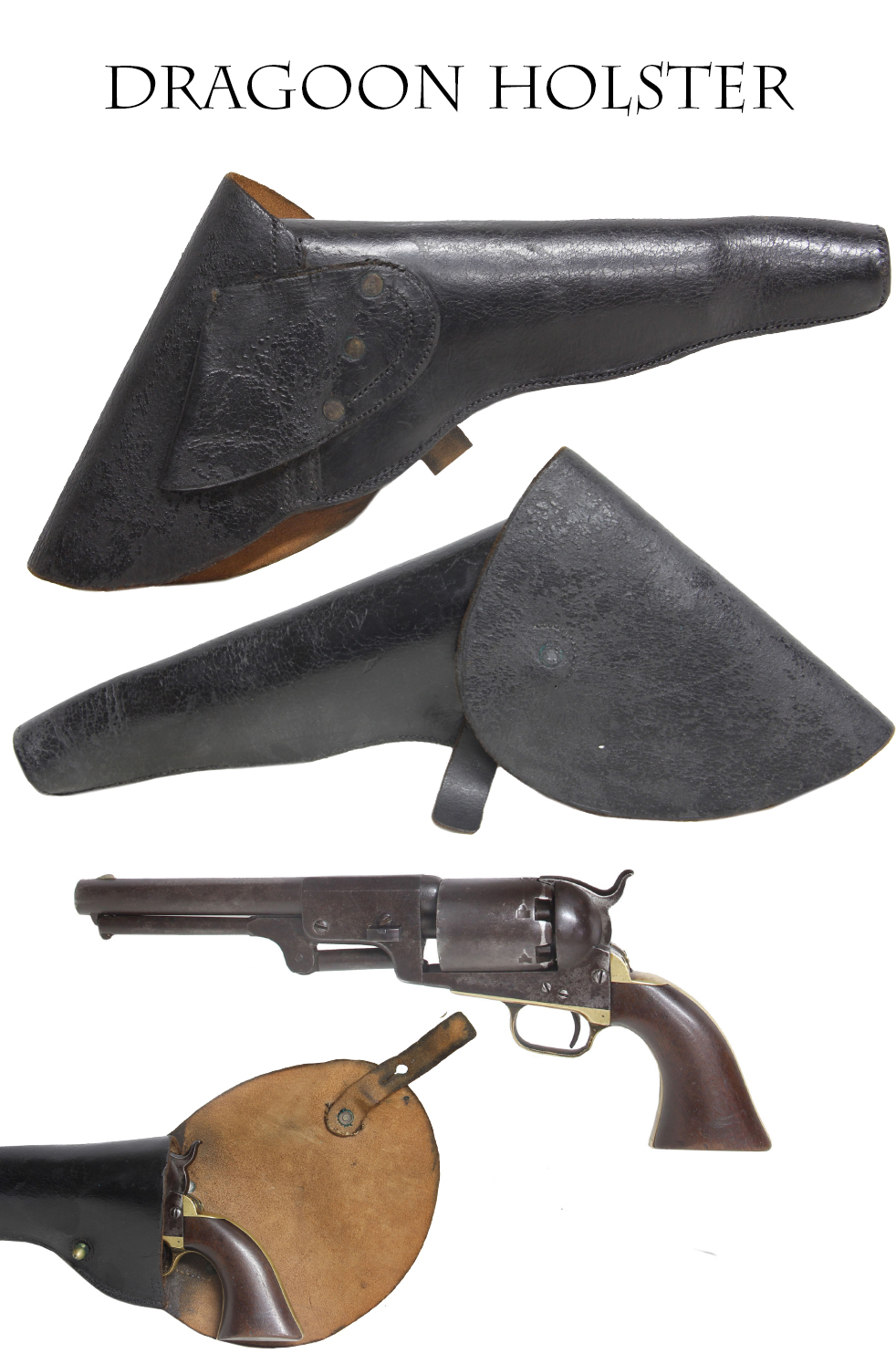
17-06-88 …DRAGOON HOLSTER … RARE FIND! Large Civil War production holster for the Colt dragoon revolver. I keep my eye out for these all the time and when I am lucky enough to find one it usually comes home with me. Regulation military holster configured to hold the revolver butt-forward. Black bridle leather with large belt loop on the reverse secured with rivets and stitching and the latch tab still in place, also secured with stitching and a rivet. The toe plug is in place and the holster shows lots of great original finish. The flap shows some alligatoring from flexing and the belt loop shows a little finish loss on the upper rear quarter from wear against the soldier’s body, but these are minor points and are not very noticeable. The body is solid, with great finish and all seams intact. You will have to look long and hard to find a better example of this scarce holster. We sold its twin brother in 2014 for $1,950.00. I found this one at a real friendly price and can sell it for $1,450.00
sold
Call us @ 419-842-1863
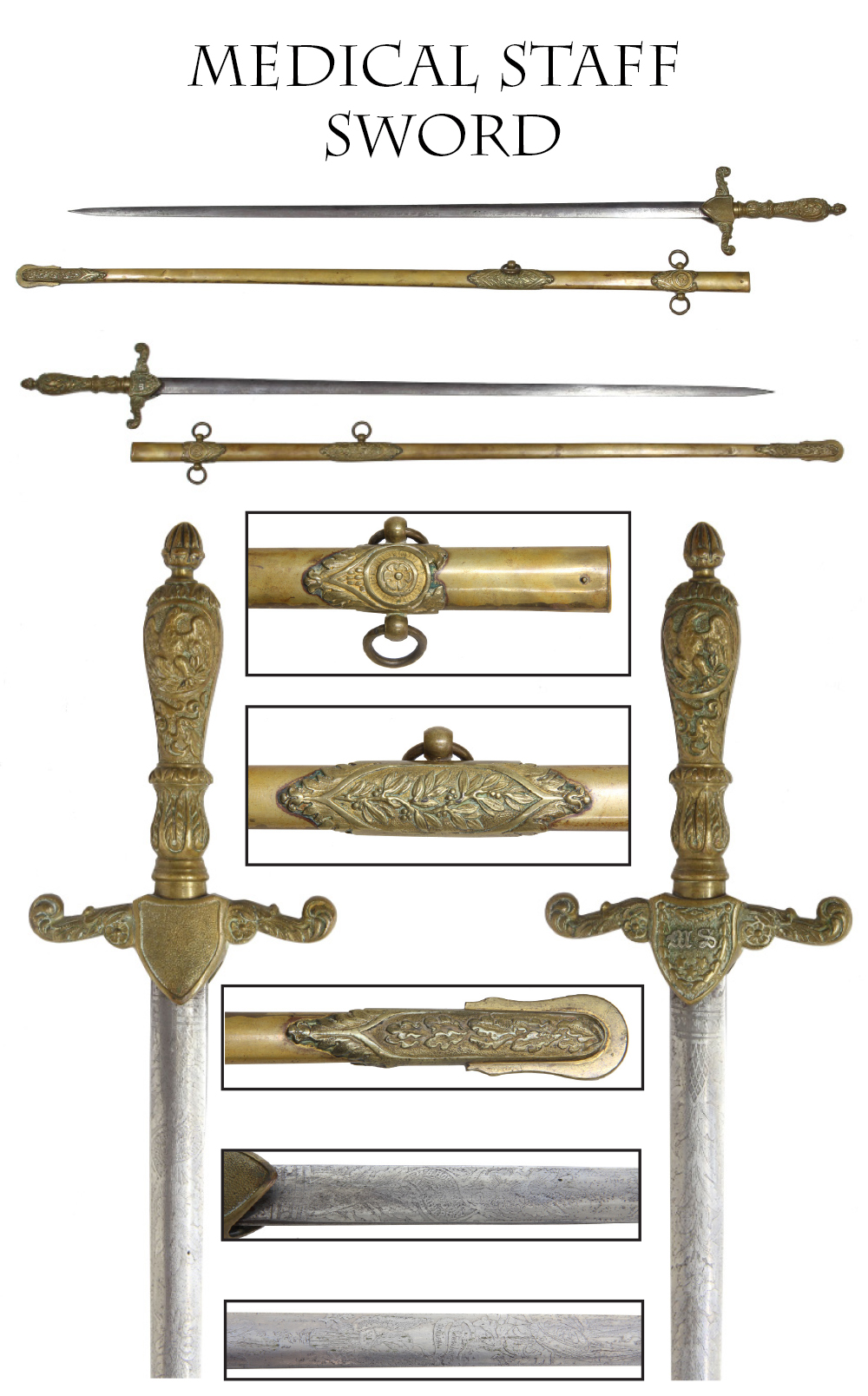
17-06-89… CIVIL WAR SURGEON’S MEDICAL STAFF SWORD… Very scarce US model 1840 regulation sword for officers of the medical staff. Regiments were allotted a Surgeon and an Assistant Surgeon, and in later 1862 a second Assistant Surgeon, to attend to the medical needs of the men. In addition to their “MS” hat insignia and green sashes, they were distinguished by the pattern of sword authorized for their wear. This has the correct straight blade with elliptical cross section that sets it apart from later versions. The grip is brass with a pineapple shaped pommel finial, and a molded grip with acorn, oak and acanthus leaves surrounding oval panels with American eagles in them. The crossguard consisted of two scrolling branches, also decorated with floral motifs, and two shield-shaped langets, one blank and the other with an “MS” and stars surrounded by draped laurel sprays. The scabbard is likewise brass, with floral decorated mounts, the upper one bearing two carrying rings and the lower mount, one. The brass has an even, medium patina with just a minor small dent or two near the drag. The blade is medium silver gray with visible etching showing a US eagle and motto, a mix of floral sprays and a military trophy, and a swirling, leaf shaped cartouche inside which is etched the dealer’s name: “W.H. Horstmann & Sons Philadelphia”. Thillmann shows this pattern on page 152 of his Army Swords, and postulates that it may be an earlier version of the Hostmann pattern since it shows a more refined hilt casting, with greater depth and detail. I love the way that maker’s cartouche is etched as well. $1,750.00
Call us @ 419-842-1863
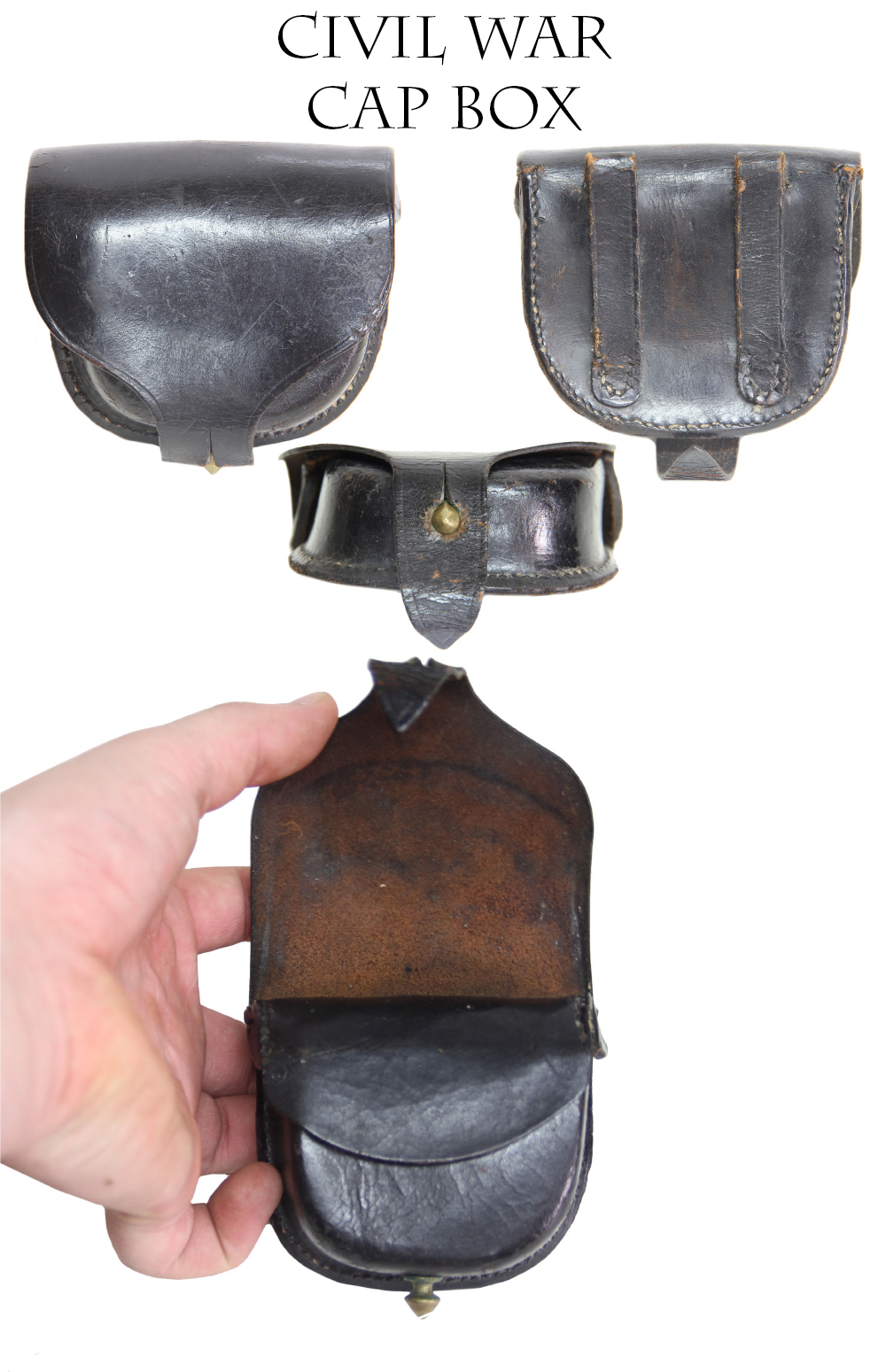
17-06-90… EARLY WAR CIVIL WAR CAP BOX… An excellent example of the regulation pouch for carrying percussion caps. When most Civil War arms required separate primers for paper wrapped or cloth cartridges just about every infantryman and cavalry trooper wore one of these. This one has great finish remaining on the black leather and shows the early war construction of the belt loops bearing no reinforcing rivet. Some extremely minor abrasions to the edges of the belt loops and minor crackling to the finish. Overall super. A darn nice example. $165.00 Sold
Call us @ 419-842-1863
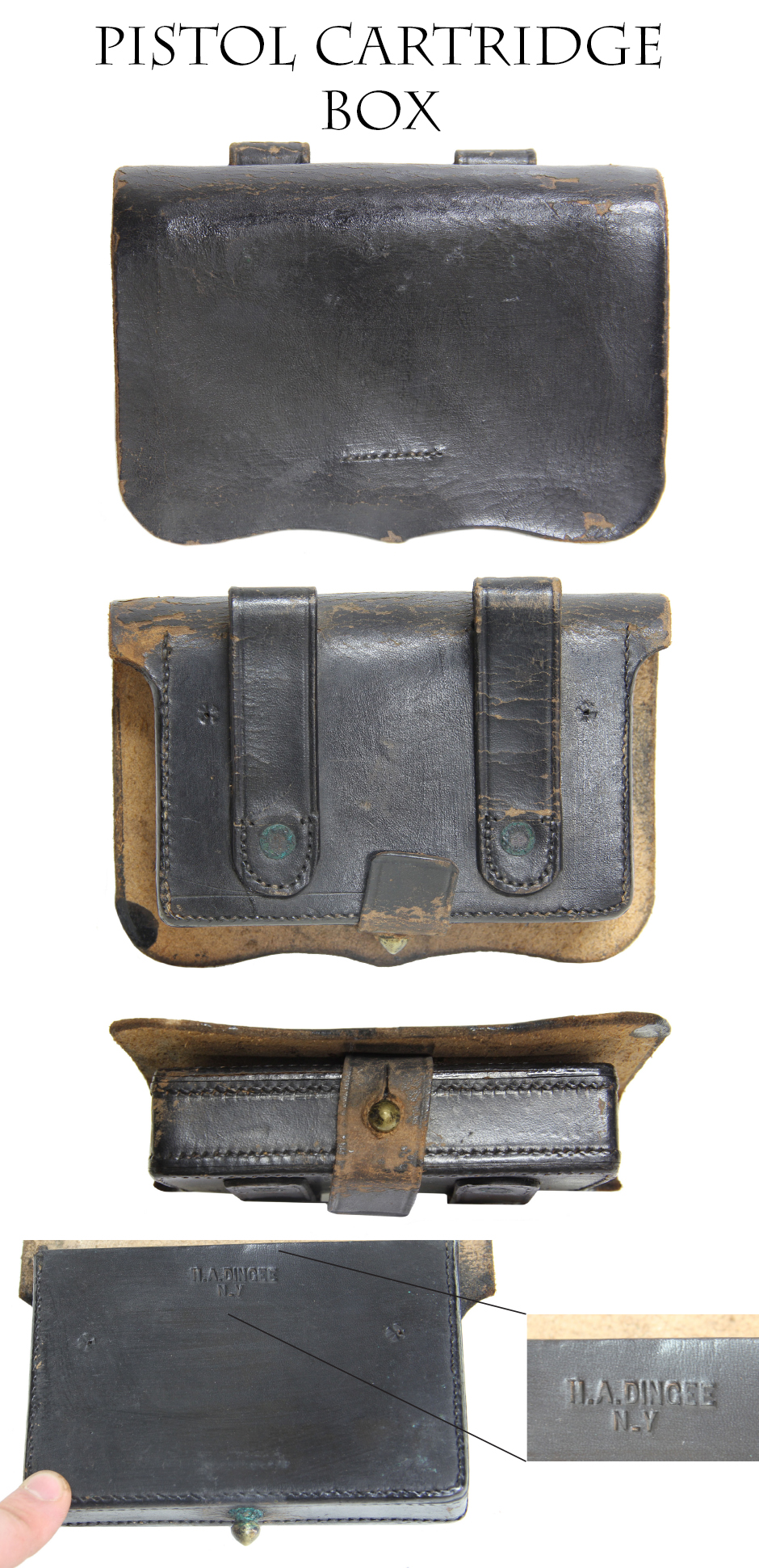
17-06-91… EXCELLENT PISTOL CARTRIDGE BOX… Scarce H.A. Dingee / N.Y. marked cartridge box for revolver cartridges. This is the middle size showing the early war straight line stitching and with rivet reinforcement on the belt loops. There are several variations of these boxes: three different sizes based on the changing configurations of the cartridge packs and several variations in construction. On top of that there are a number of makers so they can be a challenge to collect, but all are a basic requirement in a cavalry collection. This one has great finish remaining on the leather, just some minor scuffs and a little finish loss on the latch tab, which is to be expected, from flexing. Dingee is probably the biggest name in suppliers of leather gear to the army before the war and had a number or wartime contracts. His holsters turn up, but his name on pistol boxes is a bit elusive. $235.00
sold
Call us @ 419-842-1863

17-06-92… MINTY 1864 ACCOUTREMENT SET… A minty infantry accoutrement set like we used to find, but even rarer because we never found the buff leather shoulder straps in the old days. Excellent buff leather infantry waist belt, originally black, now oxidized to a deep brown, with minty large oval US 1839 pattern infantry belt plate with arrow (or “snake-head”) hooks, and correct beveled belt prong, with lots of its original gilding in place. Open, flat brass C-clasp keeper in place, and Fall of 1864 pattern cap box that dispenses with the inner flap and attaches the side ears to the cover. No pick or fleece remaining, but the upper portion of the sheepskin strip is still there (used to keep the percussion caps from bouncing out if the soldier left it unfastened.) With this is a minty 1864 pattern cartridge box made and marked by R. Nece on the inner flap with a crisp a stamp and an equally crisp A.D. Laidley Ordnance Department sub-inspector stamp next to it (the sub-inspectors were the ones out in the field actually doing the work!) This is complete with correct US embossed outer flap, inner implement pouch with flap and tab, both magazine tins and all buckles and belt loops in place, and latch tab firmly secured with stitching and rivet. To top it off, the box still has the incredibly rare black buff shoulder sling in place. Like the belt, it has oxidized to a brown mixed with black, that shows no provision for a shoulder belt plate, as is correct for this pattern that dispensed with plates on box and sling. Completing this infantry set is a .58 caliber socket bayonet with a clear US stamp at the blade shoulder and locking ring in place, with good edge and point, showing a dull silver overall with just some rising brown here and there on the blade and slightly more on the socket from exposure. The scabbard is the regulation eight-rivet scabbard with black bridle leather body that is firm with no bends or breaks, and brass tip in place. Like the waist belt and shoulder belt, the belt loop on the scabbard is black buff, retaining a bit more of its black color. A very nice complete Union infantryman’s accoutrement set in extraordinary condition. I guarantee there isn’t another such set for sale this year at anywhere near this price. $2,200.00
sold
Call us @ 419-842-1863
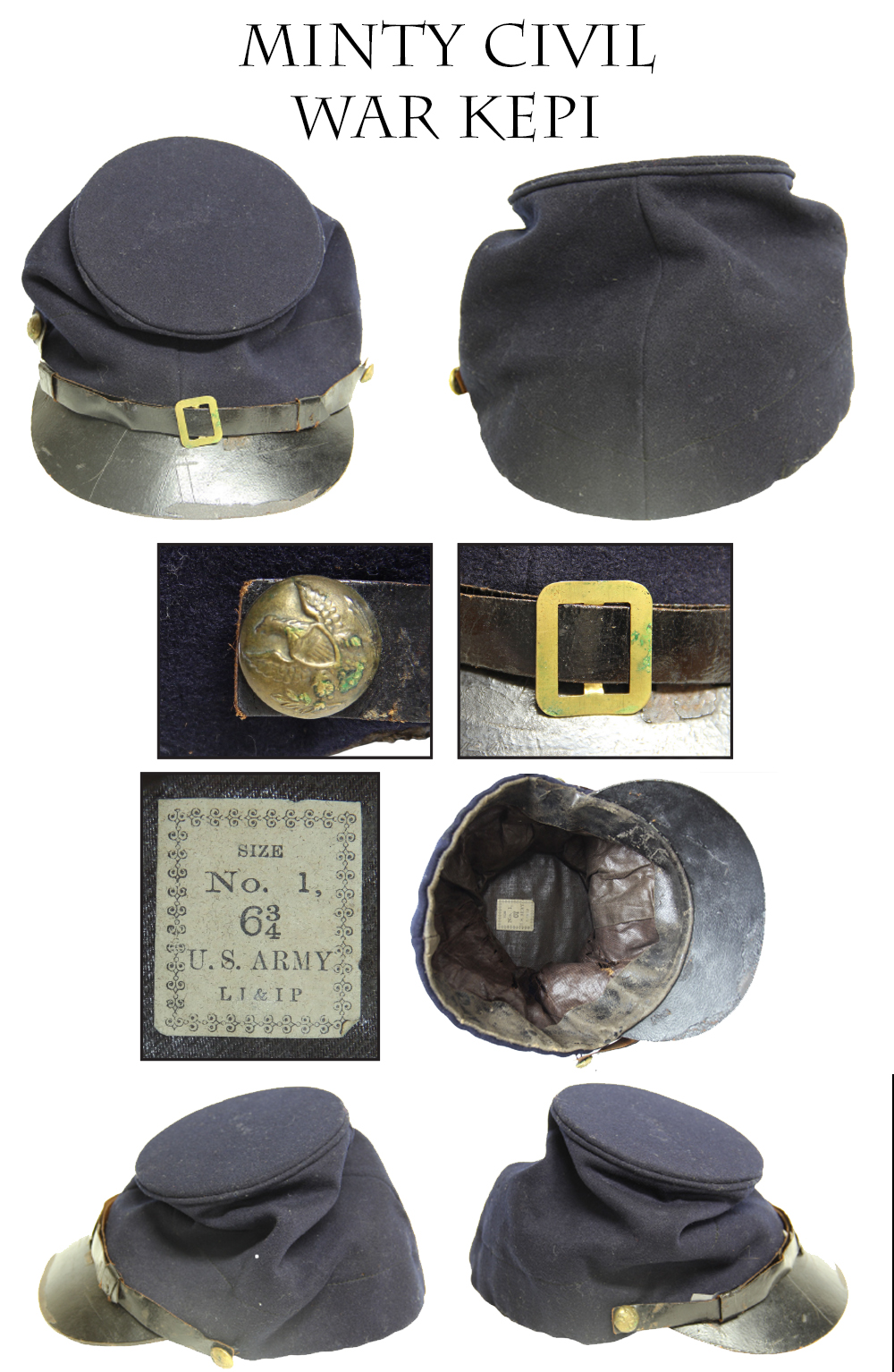
17-06-94… 17-06-94 THE BEST CONDITION CIVIL WAR KEPI I HAVE OWNED! I have owned a wheelbarrow full of these things over the past 45 years, and this one is unquestionably the best condition cap I’ve ever had. The quintessential piece of Civil War headgear- the regulation Union army forage or fatigue cap. Excellent condition blue wool exterior with virtually no moth damage. Both side buttons in place and the original two-part chinstrap that works with two standing loops and a sliding flat brass buckle that acts as a stop to adjust the length. The undamaged sweatband is firmly in place and secure, as is the full, intact lining with its maker and size label also still in place, reading: “Size / No. 1, /6 ¾ /U.S. Army /L J & I P.” Collectors will recognize this instantly as a product of Lewis J. and Isaac Phillips of New York, who had contracts for hundreds of thousands of caps throughout the war. Most of the caps we see made by them are the later war, boxy style cap with larger diameter top and a flat visor. This is one of the scarcer examples of what collectors have come to call a “Type-1” that shows a smaller diameter top, and a curved, downturned visor. The classic Civil War cap, used by every branch of land service. You can’t find a better condition example. The Best… $2,850.00
sold
Call us @ 419-842-1863
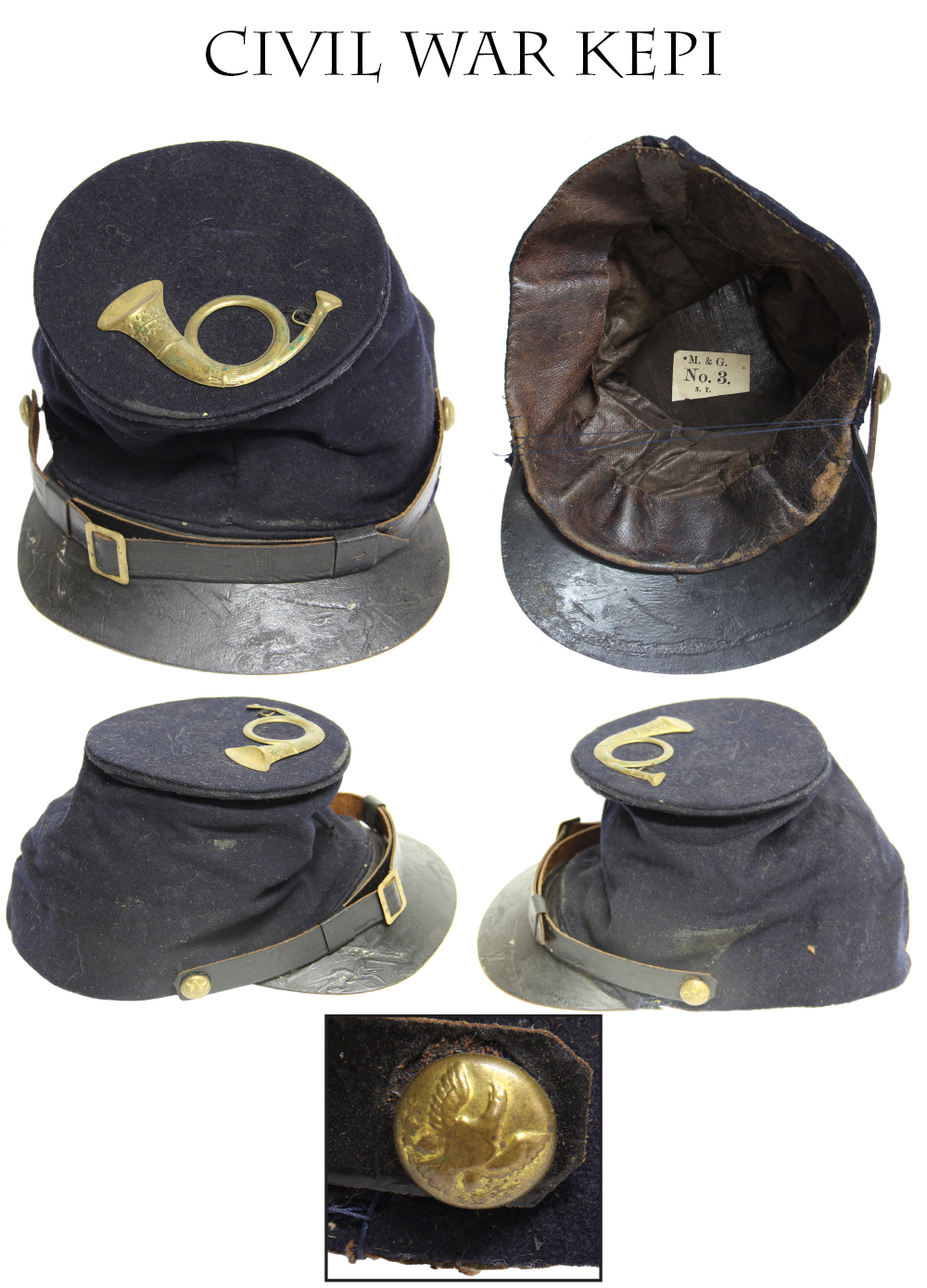
17-06-94 B.. REGULATION CIVIL WAR FORAGE CAP: Another dead-on regulation Civil War M1858 forage cap, aka “Bummers Cap”. This one fresh from a western Michigan tag sale that also yielded some officer’s embroidered insignia. Overall excellent condition and complete, just not as “minty” as the above kepi. This has the original sweatband, original brown polished cotton lining, original maker’s label “M&G No3 N.Y.” Also has original chinstrap and side buttons. Totally original and complete. The blue wool body is very attractive with deep midnight blue color. There are a couple TINY moth nips of no consequence. Has an original infantry hunting horn insignia attached to the crown. A great looking and very solid example of this highly sought Civil War antique. These were scarce forty years ago… A must for a display of Union Army soldier effects. We sold another M&G cap in 2010 that had repaired moth damage for a hundred dollars more than this superior cap, seven years later. Super good deal at $2,350.00
sold
Call us @ 419-842-1863
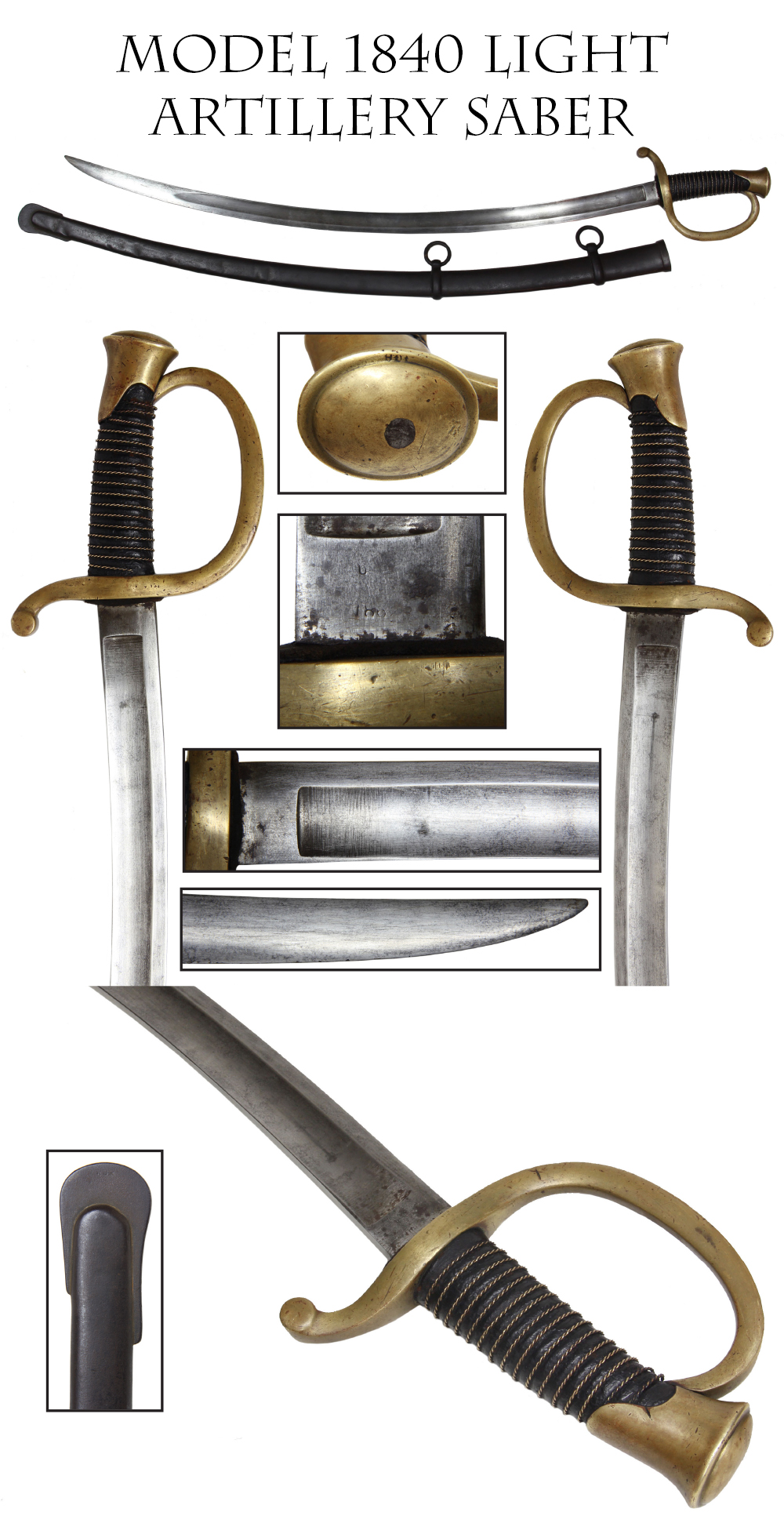
17-06-95…. REGULATION CIVIL WAR M 1840 LIGHT ARTILLERY SABER: Sabers for cannoneers ? Yes… Artillerymen might have to resort to personal weapons to defend themselves or their guns in a close fight. Caisson and limber drivers were mounted and might find themselves engaged with cavalry or surrounding infantry. Horse artillerymen were all mounted and might find themselves at an awkward moment confronted by an enemy trooper. This is a regulation example artillery saber, made by Ames, that was cleaned and burnished at some point, possibly for reissue, leaving just light traces of the US mark and part of the date on one side of the ricasso, and obliterating the maker’s mark completely. Overall VG condition. The wire is a tad loose just under the pommel cap. The blade was obviously cleaned at some point and now shows a dull silver, smooth, showing a few light brown spots here and there. The scabbard has some minor dents near the drag and shows a deep russet brown. The throat, rings and drag are in place and there is a small set of inspector’s initials on the tip of the drag. A nice representative example of a regulation US enlistedman’s saber fairly priced. $650.00
sold
Call us @ 419-842-1863

17-06-96…. OFFICER’S PISTOL BELT This is a regulation Civil War officer’s waist belt made of folded leather with a fixed hasp on one end and narrow brass adjusting buckle on the other that enables the wearer to tighten the end of the belt feeding through the slot of the belt plate. The leather safe is still in place behind the hasp, and the plate and hasp show matching bench numbers, indicating they have been together forever. There are no saber straps present so this belt is rightly called a pistol belt that would have supported a holstered revolver, cap box, and pistol cartridge box. (Both pieces available on this web-catalog). The plate is the regulation 1851 pattern for sword belts and shows the integrally cast wreath that is characteristic of the commercially produced plates purchased by officers. The leather is in very good condition with just one or two points of abrasion. The brass has a matching, medium patina. Very solid example
$395.00 sold
Call us @ 419-842-1863

17-06-97…. SQUARE TOED CAVALRY OR OFFICER’S BOOTS… A beautiful, dead-real Civil War period pair of square toed boots with pegged soles and heels. These are perfect for a cavalry or officers display. These are in remarkable condition, about the best I have seen in forty years of looking for this material. They appear to be about a size 9 or so. Has square cut tops. Cloth web pull tabs are sewn at the tops to aid in pulling them on. The upper portions are lined with softer kid leather. The black leather is supple and glossy, yet stiff enough to hold the boots upright for display. I see just one small hole on the upper left of one boot just forward of the side seam. This could be easily filled in and disguised for display, but they look great as is. Civil War issue boots were low and rather ugly looking affairs and men often went for a privately purchased pair instead. Officers, of course, had to buy all their gear on the private market. Even infantrymen in winter and foul weather went to boots in preference to the issued brogans. A really great looking Civil War pair of boots.
$495.00
sold
Call us @ 419-842-1863

17-06-98… POTTS BOWIE KNIFE-BAYONET… These magnificent unmarked bowie bayonets are believed by some to have been made by T.A Potts in New Orleans on the basis of one specimen marked T.A. Potts New Orleans 1840. Unfortunately, while that knife is real, the makers stamp is spurious in my opinion, added years ago to make it unique and more saleable. Some now believe these Potts knives were actually made by Rees Fitzpatrick of Natchez, Mississippi. More recently, collectors and arms scholars have also come to realize that they were probably made as dual purpose weapons not as a side-knife and bayonet, but as a knife and as a polearm spearhead. The attaching rings are always unfinished on the inside and have no provision to actually fix it to a rifle barrel and keep it there, let alone in any one position. It has been rumored that an example surfaced with an old capture note indicating it had been used as a detachable spear point on the staff of a battleflag, but I have not seen the documentation. It does make sense that the loops would be better adapted for a friction fit to a pole, whether for use as a flag finial or pike, but the research is still ongoing. It is a dead real Confederate sidearm in any case and a very stylish Bowie with swept back clip-point blade, and swept back muzzle or staff rings that accentuate the sleek profile. The quillon rings are excellent, so is the grip, and the blade is bright, with excellent point and edge, no nicks, and just a few light scratches and some small gray spots near the guard. The knife still has its scabbard, which is even rarer than the knife. Brass throat and tip are in place. The throat still has the fastening button and a small bottom piece of the belt loop that came up at an angle and fastened over it is still sewn to the scabbard edge lower down. The leather scabbard is solid, but does show finish loss and abrasions, but has never been treated with any kind of leather dressing or preservative. A classic Confederate edged weapon, in excellent condition, with its rare original scabbard. $2,750.00
Call us @ 419-842-1863
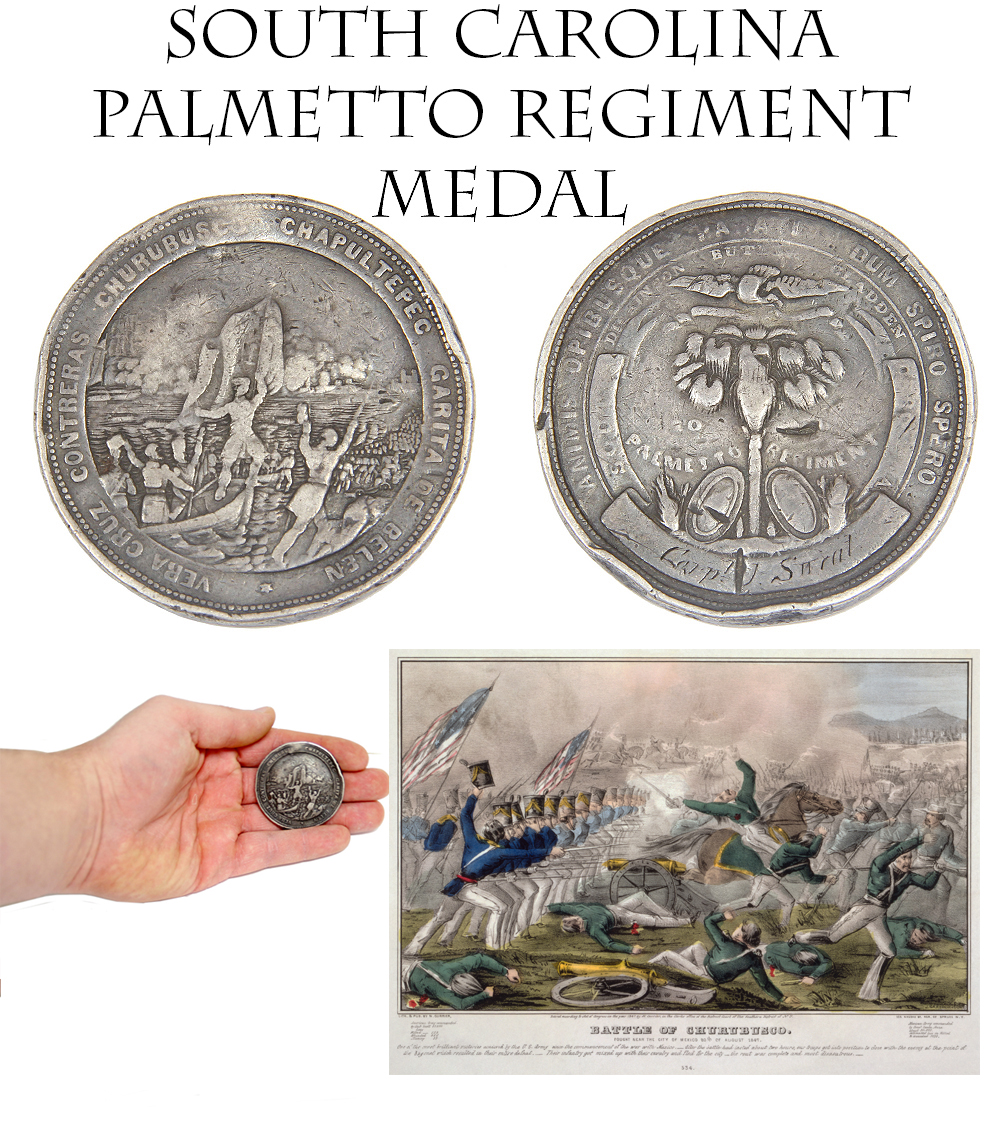
17-06-111…EXCEEDINGLY SCARCE SILVER SOUTH CAROLINA MEXICAN WAR PALMETTO REGIMENT MEDAL INSCRIBED TO CORPORAL JOHN SWEAT OF COMPANY K…The South Carolina House of Representatives authorized distribution of these medals, gold for officers and silver for enlistedmen, in late 1848 and they were distributed in 1850. William Glaze, well known to Civil War collectors, was first touted as the engraver, but the work was eventually done by William Keenan and the production of the medals was entrusted to Gregg, Hayden & Co. The Charleston Courier described the medal as follows: On one side is represented the landing of the American troops at Vera Cruz, the gallant leader of the Palmetto Regiment, Colonel Butler, having sprung from the boat that bore him to the shore, and with drawn sword, is calling on his command to follow—a figure, bearing the beloved Palmetto Flag, is on the prow of the boat, about to leap on shore, and plant the Standard, around which all appear eager to rally. To the right, are serried columns of troops on the line of march toward the Castle at San Juan; while in the distance is seen the American fleet, covering the landing of more troops, which are approaching the shore in boats. Around the edge of this side of the Medal, in raised letters, are the names ‘Vera Cruz’, ‘Contreras’, ‘Churubusco’, Chapultepec’, ‘Garita de Belen’” On the reverse, is delineated a beautiful Palmetto Tree, resting against the trunk of which recline two shields, bearing the dates ‘1846’ and ‘1847’. Hovering over the tree is a spread winged eagle, from whose beak floats the motto of the Union, “E Pluribus Unum”, immediately above which, in a circle, is inscribed the names of ‘BUTLER’, ‘DICKINSON’, and ‘GLADDEN’. On the outer rim are the State mottos, ‘Animus Opibusque Parati’ — ‘Dum Spiro Spero’. In the centre of the medal in curved lines, are the words “To the Palmetto Regiment,” and at the foot and lower edge is the scroll, for inserting the name of the recipient. Our medal is engraved “Corpl. J. Sweat” in the scroll and there is only one candidate: John Sweat of Company K, commanded during the war by Walker and O’Bannon. The company was organized in 1846 in the Barnwell District, later Barnwell County. The officers named on the medal were the field officers of the regiment at Churubusco, two of whom were mortally wounded carrying the regimental colors. At the Belen Gate at Mexico City the regiment’s flag was reportedly the first raised over the captured works. John Sweat shows up as a private on the roster of Co. K, Walker and O’Bannon’s company, organized in 1846 in the Barnwell District, SC. He survived the war, though a Paul Sweat in the same company did not, dying November 2, 1847 at Puebla. A relative of our man? Our hero apparently had died by 1899, for he does not appear on the list of survivors compiled by private John Cantwell of the regiment in that year. There are some dings to the edges of the medal, some expected wear to the high points, small scratches and one small gouge between “corp’l” and “J. Sweat” that does not affect the text or design elements. This is a very, very scarce early American military medal from a fighting regiment in the Mexican War and there is potentially a load of other research waiting to be done on the soldier. I’ve seen a few of these in Mex War displays over the years, but this is the first one I have personally owned…
$1,750.00
sold
Call us @ 419-842-1863
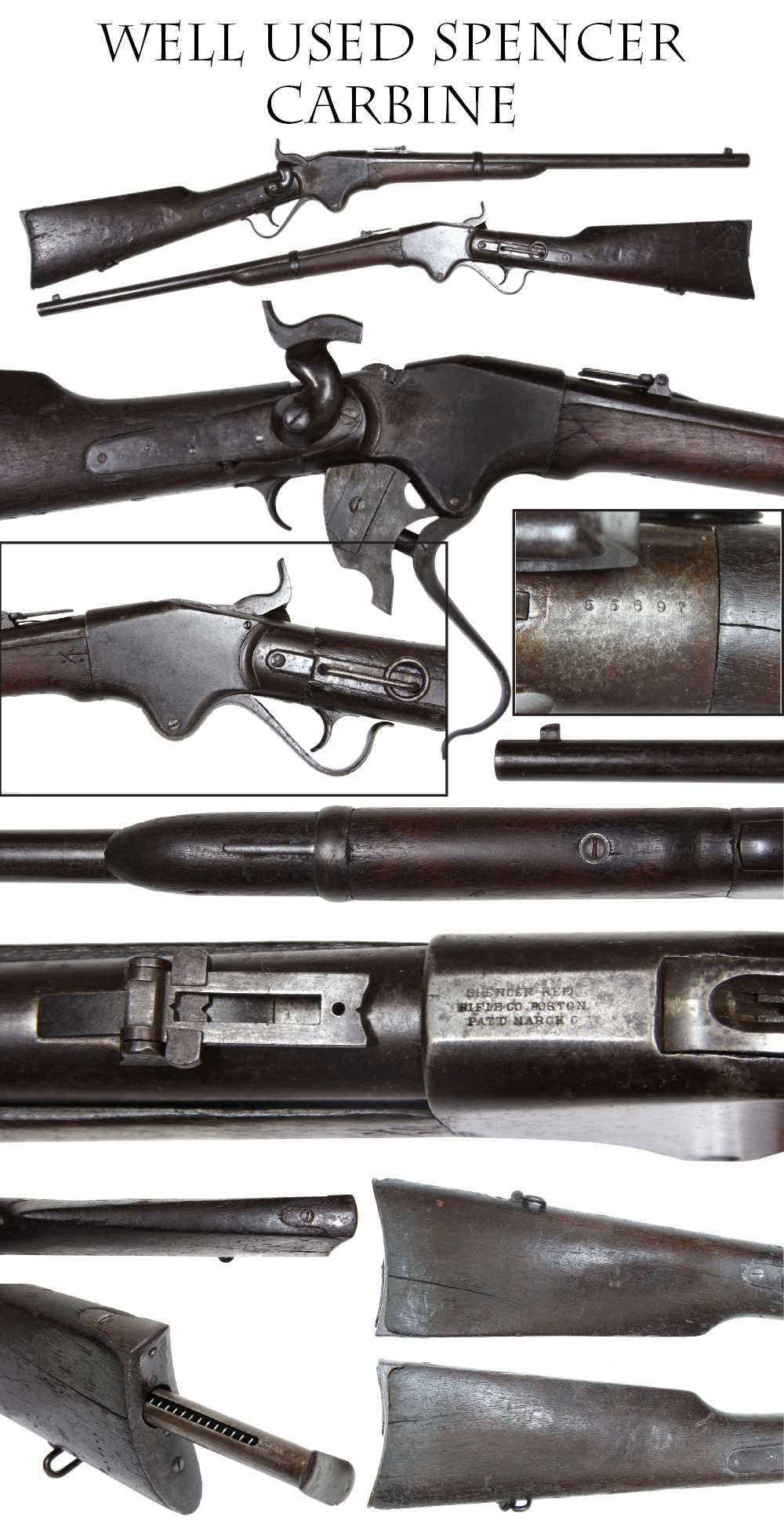
17-06-112…WELL USED 1860 SPENCER CARBINE… The quintessential Yankee cavalry carbine, an 1860 Spencer carbine. The seven-shot Spencer was a robust weapon that gave Federal cavalry some impressive firepower. This one shows numerous dings to the wood, indicating some active field use, but is still a very respectable example. Smooth metal with clear, legible Spencer marking on the top of the receiver and serial number 55697. Barrel has deep brown patina. Receiver is a mix of pewter and gray with some light brown.
Sights, sling ring and butt swivel in place. Rear sight lacks tiny retaining screw on the ladder. Small “x” carved at rear of forend on either side. Narrow, stable crack at top of wrist and on either side of the buttstock at the magazine tube, which is pretty standard. The magazine tube is in place. A well-used, honest example, priced right.
$1750.00
Call us @ 419-842-1863

17-06-113… WHITNEYVILLE RIFLE MUSKET… A wonderful example of Yankee Ingenuity “Whitney Style”. Whitney had a sort of “spaghetti against the wall” approach to arms supplying. His muskets often used odd parts he gleaned from a variety of sources, including the US Arsenals. This musket is a Springfield M1863 which has been married to a Whitneyville M1861 lock, with the M1861 hammer severely canted to properly strike the nipple. I have no idea whether Whitney or another arms seller sold this “good and serviceable”… I will leave that bit of detective work for you. When Whitney obtained a second US contract in October, 1863, for 15,000 1861 pattern rifle muskets, his first guns had been sitting around from the earlier contract and the remainder, true to form, show a number of variations. This is a good example of the second pattern of lockplate markings he used, a more conventional eagle and US with “Whitneyville” forward of the hammer and a vertical 1864 date at the rear. The barrel, however, shows an 1863 type bolster with no clean-out screw and stamped with an eagle, and the bands are the round 1863 style. These parts appear to be ex Springfield Arsenal. Metal shows some light peppering near the breech and on the bolster from firing, but is generally smooth and light silver-gray in tone. The lockplate shows a mix of gray and pewter that are the remains of case. The lock markings are crisp, though the bolster eagle shows peppering and the tip of the hammer is a little crusty. Sights, bands, springs and swivels in place. No rod. Short range sight leaf is replaced. Sharp V/P/eagle barrel proofs. Wood is very good. Very slight rounding and a few light wear marks. No significant dents or divots. A little crustiness to the buttplate heel from standing upright on a floor. A classic Civil War long arm and from a famous American gunmaker who is a collecting field unto himself… $875.00
Call us @ 419-842-1863

17-06-82… COMMERCIAL GERMAN WW-2 BLACK LEATHER KRIEGSMARINE? COAT AND PANTS: Freshly found by helper Chuck right here in our own backyard. Not government contract, but certainly a commercial German military man’s foul weather suit, brought home as a souvenir by a local NW Ohio soldier. Both pieces fabricated from black leather. Interior of coat has tailor’s label of Fritz Paffrath, and we find that Herr Paffrath is absolutely a WW2 maker and is known to have made black leather SS coats, as well as this style. Our set is very similar to the Kriegsmarine foul weather leathers worn by German naval officers (see illustrations), but does not conform precisely with government contract examples. It was obviously a commercial product. It may even have been worn by a Wehrmacht motorcycle rider. It has nondescript civilian buttons. It is possible these buttons were added after the war by the local G.I. who brought it home. It would make perfect sense for our veteran to have continued wearing such a well made leather coat. Without German insignia or buttons it would have been high fashion in Toledo in 1946. Or it is possible the buttons are the original buttons worn in Germany. Coat has two horizontal flap pockets and a waist belt. It does not have the slash pockets at abdomen level seen on the contract navy coats. But viewing the illustration photos it is clear the coats were made with variant collars and pockets. Trousers have three pockets and are lined similarly to the coat. Condition is excellent and I venture to say could still be worn with care. Displays like a million dollars, and definitely a real 1940s German foul weather set…. $850.00
sold
Call us @ 419-842-1863
Layaways are Welcome
Need to split your order into multiple payments? No problem! A simple 20% earnest money deposit will hold your item for you.-acf
You can then pay it off in easy installments that fit your budget.
Read Terms Here
Items to Sell? Contact Us
I am always interested in buying ANYTHING from the American Civil War… Guns, Swords, Civil War Muskets, Knives, Uniforms, Flags, Medals, Badges, Diaries, Letters, Autographs, Buttons, photographs, tintypes, daguerreotypes, Insignia, Camp Items, Battlefield Relics, canteens, Drums, Etc… Call 419-842-1863 and ask for Dave Taylor.

